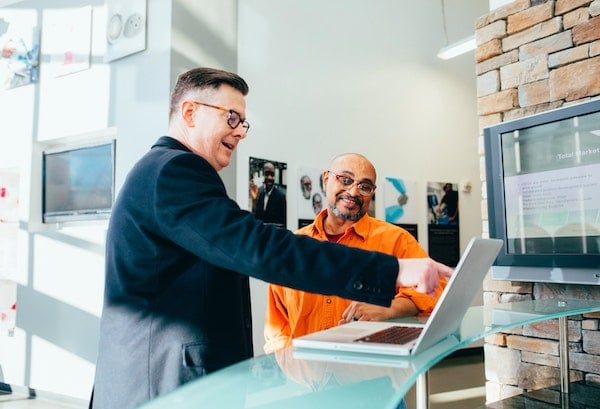Published on
Developing Strong Relationships with the Business Community

Students are looking to get back into the workforce, and institutions need to work closer with industry partners to create programming that will meet the needs of both. In creating strong relationships, students see how much you care about their education and will be motivated to return to the institution they trust. In this interview, Simone Rodriguez and Christine Zagari-Loporto discuss the importance of relationships between higher ed and industry, the challenges they face and how to build an engaging environment with partners.
The EvoLLLution (Evo): Why is it so important for a college and universities to have close relationships with industry and employers?
Simone Rodriguez (SR): Robust relationships between institutions and industry partners are critical for building strong workforce development programs. Having these relationships ensures that the curriculum being taught to students is relevant to the careers they will enter, whether they are seeking immediate employment or planning to enter in the next few years.
Now, these relationships also serve the needs of industry by creating a pipeline of skilled employees from educational institutions through a company organization. For example, Continuing Education must embrace its role as industry partners and help their students realize their ambitions by being attentive to developments in the job market and employers’ evolving needs. This can only be done when institutions and industry work closely together.
Building and maintaining strong relationships with local industries has a long-running benefit for colleges because we can develop an in-depth understanding of the local employment environment. This relationship can help inform college leaders’ decisions, develop programs that the college targeted and provide students with an education that prepares them to enter the workforce.
Evo: What is the value in strong relationships with an institution?
SR: It’s important that the institution has these partnerships because, in one aspect, it shows the students how important it is to keep the curriculum they’re receiving up to date and connected to the industry.
For example, we’ve had a technology roundtable conversation with our advisory board, and they’re able to then inform us as we’re designing our curriculum, so it’s relevant. We’re working now with several partners around user experience and healthcare, having conversations with them about the internship experience and aspects that can enhance the skill sets for students.
We want to make sure to incorporate the latest skills into the curriculum. That way, once those students go out into the workforce or into internships, then there is definitely a connection between what they’ve been able to learn from us and what they’re going to experience with the employer.
Evo: What are some of the challenges that you guys face in developing great relationships with industry partners?
SR: There are several challenges in forming richer partnerships with industry in sufficient time to cultivate meaningful relationships. There’s also a general lack of understanding of each other’s organizational structures and mission that we have found to be a barrier to developing productive relationships. Many of our projects are funded with the intention of forming advisory boards and hiring industry liaisons. However, once funding runs out, institutions are no longer able to sustain the industry liaison positions, and relationships are dissolved.
So, we seek these grants and the work is coming together nicely and the partnership is moving along, but then the grant ends, the staff member is no longer there, and suddenly that partnership was not necessarily with the institution but with the staff member. So, when the staff member leaves, so do their goals and the partnership. There has to be a better way for us to maintain that relationship, and that’s one of the challenges that we definitely see.
Evo: How do you build an environment that’s conducive to true B2B engagement?
Christine Zagari-LoPorto (CZL): So, what we’ve done is engage our full-time staff in these meetings. For instance, our director of training programs needed to be involved in these conversations.
Since then, this person particularly has been involved in all of these conversations and now helps design the advisory board. It takes some time away from other duties previously assigned to them, but we have seen the benefits of adding these duties to their scope of work. Recently, a project ended, a staff member left, and instead of losing the contact, the director knew the employer on a first-name basis and was able to say, “guess what? we received funding for another project. Would you like to collaborate and help us write the curriculum?” And the partnership seamlessly continues….
So, it really is about keeping a sustainable practice of staff involvement and not just having one-off grant staff members.
SR: The relationship is not just on our end. Although we may have this full-time person, if we’re meeting with an industry partner, we would love to not only meet that one person but other individuals from that team as well. So, if that person leaves, there’s a handoff to keep continuity with Kingsborough and have the conversation be ongoing.
Evo: How do you know when you have a great relationship with an employer?
SR: Some of the characteristics for a strong relationship would be ultimately to maintain active and sustained engagement. From our experience, employers are more eager to participate when they see the fruits of their labor, often in the form of curriculum, internship or mentoring programs. So, this means setting up a strategic plan, forecasting the deliverables and goals with employers for full transparency.
Some of the interaction is time-consuming on the employer’s part. We found that laying it all out and showing employers what is expected, has gotten better and more engaged buy-in. In this post-pandemic world, more than ever, we need to be able to reflect the skill sets necessary to make a productive workforce. The only way to do that is for the important knowledge on the positions that they need or anticipate will need filling.
CZL: I would say that some of the characteristics are comfortability. We were applying for a health care program, and it was great to—and I’m going to use an outdated term here—go to our Rolodex, flip through and say, “Who can we reach out to and get ideas on what pathways we should design?” Knowing that we have a name, a phone number, an email and an easy connection, like we were able to just draft a quick email and say, “Hey, partner, what’s going on? This funding is available and we’re thinking of applying and going for this. Could you give us some insight?” And then have immediate interaction and responses without wondering, Did I phrase that correctly? Did I use the formal letter as an introduction?
So, I think a great characteristic is that once you’ve built the relationship, you feel comfortable enough to ask questions in a time-responsive way and get responses when you need them.
Evo: Do partnerships parlay into training opportunities or ongoing learning engagements with employers, so the college becomes a preferred source for ongoing training and development?
SR: Partnerships absolutely parlay into training opportunities. We can spill out all sorts of examples. One that stands out is a healthcare partner. We’re able to really design a program specifically with them in mind. They had a need, and they wanted to work with a local partner, so they reached out. And we’ve been in this partnership with them for close to ten years. So, they are now our go-to for the program. And all of a sudden, other types of programs have been designed with them in mind. So, we are partnering in all sorts of new course developments.
Vice versa, when we needed them, where can we go? Our partner is always who we call up—and not just one person but several people from that team, who we’ve worked with along the way, who we’ve designed curriculum for, who we’ve designed programs in partnership with for employment opportunities for students.
We can do that in most industries. So, now when you tell other healthcare industry partners that you have this relationship, they’re like, “Oh, okay, can we talk more about what that relationship could look like for us? Because you have the credibility from working with long-standing partners, and that’s not always a given in this industry.
Evo: What is your advice for other community college leaders looking to cross this bridge from being a college in the neighbourhood to being one of the first thought of for learning services?
CZL: Over the years, we looked at what makes us unique, and this is what institutions sometimes don’t necessarily do. They know that dental assistants or CNAs are needed. We at Kingsborough have looked at what makes us unique: maritime program, culinary arts program, urban farm and community garden. We really try to look at those parts of the industry and see where the workforce is within those sectors.
Maritime was a new playing field for us to step into, but the New York City ferry system at one point needed numerous new deckhands because they were sending out a lot of vessels. So, we had to quickly, as workforce providers, provide a training program for deckhands. We met with the department, created a program, ran two cycles and got a majority of those students employed right away in the New York City ferry system.
Looking at that model, I said, “okay, well, what else has happened? Where are the other labor demands, and who are the other employers that we’re not speaking to, that we should be speaking to? And over the years, we’ve built this model of assessing what we have, who the major players are, then knocking on doors. We’re taking this unique programming, finding who the employers are or will be and design the training based on their feedback. Again, this is not a one-and-done. It’s an ongoing process. I think institutions really need to ask themselves, who the best employer partners to get feedback from, for input, for curriculum, for design and for subject matter experts—not just employment opportunities.
SR: It’s definitely a great example, because it’s not just a matter of always waiting for the partners to come to us. We have to find them as well. We’ve been able to delve into Europe and different parts of the country, seeking partners in a specific area, which has been helpful. Now when we’re talking to other colleagues in the state, we can say things like, “Oh, I’ve worked with a partner in this state and other states including overseas in Europe.” And all of a sudden, the credibility and value of what Kingsborough can offer definitely increases.
Evo: How important is the continuing ed division and the workforce development division, in creating this centralized hub or approach for the institution to deliver employer engagement services?
SR: As part of the conversation, the college president, Dr. Claudia Schrader wanted to make sure that career services was embedded within Workforce Development and Continuing Education. That way, there is a synergy between the partners that we are speaking with and the ones who will then be employing and interning our students.
Now we’re at the same table with career services, having conversations with partners. That way, we’re not calling multiple times. We were also able to design a database that all of us have access to, and it says, for example, The EvoLLLution is our partner. Who knows The EvoLLLution? What’s the contact information? So, when we go in, we can see that Simone only speaks to Amrit at The EvoLLLution, so that we will make sure we’re continuing the partnerships. They’re calling with a name in mind, identifying themselves as Kingsborough. That way, it doesn’t seem as if Christine is calling, Simone is calling. We’re all using the same database to communicate with our employers, and that has been really key for us in ensuring that not all the different units at the college are calling the same employers.
Evo: Is there anything you’d like to add about the work that you’re doing to engage employers and any advice that you might share?
CZL: What we laid out, especially the database, is a great idea. If institutions don’t already have one, they should. I know that I have found it useful anytime we’re applying for a grant or need employer feedback. It helps streamline the process and avoid duplicating efforts and services. It just helps open doors and gets everything done efficiently and effectively.
This interview was edited for length and clarity.
Disclaimer: Embedded links in articles don’t represent author endorsement, but aim to provide readers with additional context and service.
Author Perspective: Administrator



